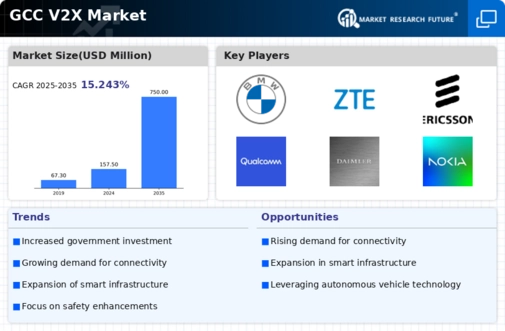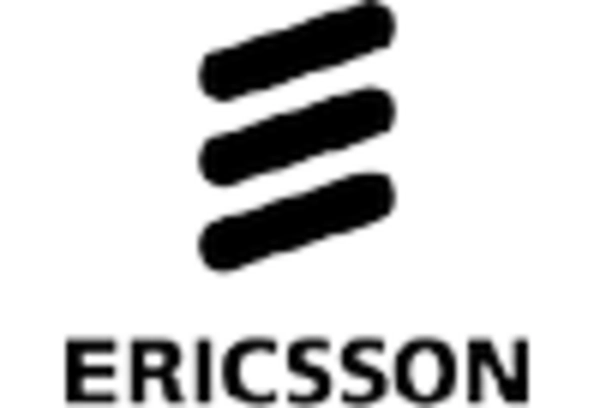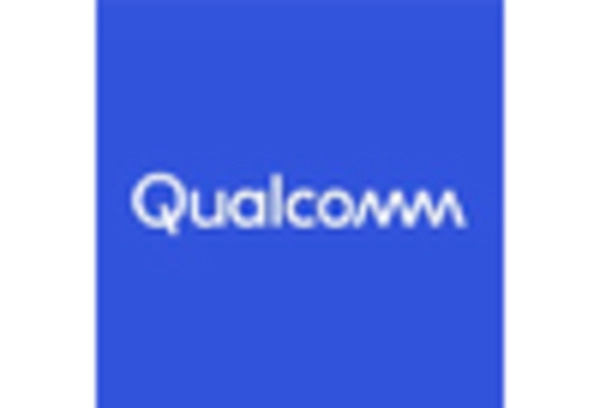Investment in Smart Infrastructure
Investment in smart infrastructure is a pivotal driver for the v2x market within the GCC. Governments are increasingly recognizing the importance of integrating advanced technologies into transportation systems to enhance efficiency and sustainability. Major projects, such as smart traffic lights and connected roadways, are being developed to facilitate v2x communication. The GCC is projected to invest over $100 billion in smart city initiatives by 2030, which includes substantial funding for v2x infrastructure. This investment is expected to create a robust ecosystem for v2x technologies, fostering collaboration among stakeholders and encouraging innovation. As smart infrastructure becomes more prevalent, the v2x market is likely to experience accelerated growth, driven by the need for modernized transportation solutions.
Government Regulations and Standards
The v2x market is significantly shaped by government regulations and standards aimed at enhancing transportation safety and efficiency in the GCC. Regulatory bodies are increasingly establishing frameworks that mandate the integration of v2x technologies in new vehicles. For instance, the introduction of safety standards for connected vehicles is likely to accelerate the adoption of v2x systems. The GCC governments are also collaborating with international organizations to develop guidelines that ensure interoperability and security in v2x communications. This regulatory push is expected to create a conducive environment for market growth, with estimates suggesting that compliance with these regulations could lead to a market expansion of approximately 15% annually over the next five years. As regulations evolve, the v2x market is likely to adapt and thrive.
Rising Demand for Road Safety Solutions
The v2x market is significantly influenced by the increasing demand for road safety solutions across the GCC. With road traffic accidents being a major concern, governments are prioritizing initiatives that leverage v2x technologies to enhance safety. For instance, the implementation of vehicle-to-vehicle (V2V) communication can potentially reduce collision rates by up to 80%. This growing emphasis on safety is prompting investments in v2x infrastructure, with the GCC governments allocating substantial budgets for smart transportation systems. Reports suggest that the market for road safety technologies in the region could reach $1 billion by 2027, indicating a robust growth trajectory. As safety becomes a paramount concern, the v2x market is poised to benefit from these developments.
Technological Advancements in Communication
The v2x market in the GCC is experiencing a surge in technological advancements, particularly in communication technologies such as 5G and dedicated short-range communications (DSRC). These innovations facilitate real-time data exchange between vehicles and infrastructure, enhancing traffic management and safety. The GCC region is investing heavily in 5G infrastructure, with projections indicating that the number of 5G connections could reach 30 million by 2026. This rapid deployment of advanced communication networks is likely to drive the adoption of v2x solutions, as they require robust connectivity to function effectively. Furthermore, the integration of artificial intelligence and machine learning into v2x systems is expected to improve decision-making processes, thereby increasing the overall efficiency of transportation networks in the GCC.
Urbanization and Increased Vehicle Ownership
Urbanization trends in the GCC are driving the v2x market as cities expand and vehicle ownership rises. The region is witnessing rapid population growth, leading to increased traffic congestion and pollution. As a result, there is a pressing need for innovative solutions to manage urban mobility effectively. The number of registered vehicles in the GCC is projected to exceed 10 million by 2025, intensifying the demand for v2x technologies that can optimize traffic flow and reduce emissions. Smart traffic management systems, enabled by v2x communication, can potentially decrease travel times by 20% and improve air quality. Consequently, urbanization is a critical driver for the v2x market, as stakeholders seek to implement sustainable transportation solutions.
















Leave a Comment